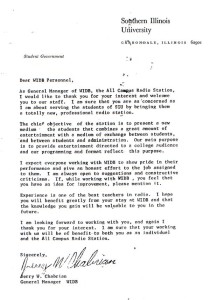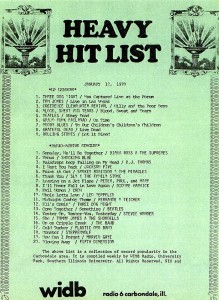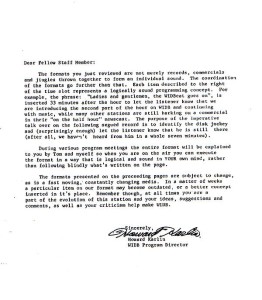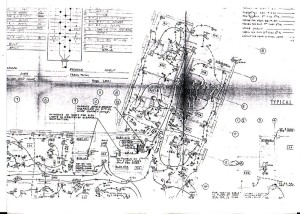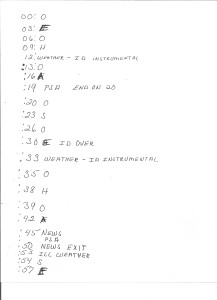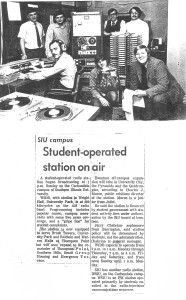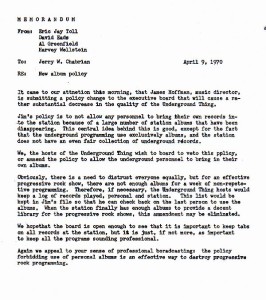Chapter 6
Station construction had four phases:
(1) Walls/windows/doors;
(2) Installation of equipment (including telephones);
(3) Installation of transmitters in dorms; and
(4) Wiring it all together and making it work.
Obviously, (1) had to be done first.
Money had been appropriated for studio construction. But, before materials were purchased, it was discovered that putting in a purchase order for building materials would trigger an inquiry from Physical Plant about the union labor needed to install the materials. WIDB members wanted to perform the labor themselves. But university policy (and the contracts they had with unions) required union labor (at union rates) to install walls and windows. The ostensible purpose of this policy was high quality construction. From today’s perspective, it appears that the actual purpose of this policy was to get as much money as possible into union members’ hands, and to use student fee (here, activity fee) money for this purpose whenever possible. The effect of this policy, if literally enforced, would have been to prevent the birth of WIDB since WIDB had a very small total construction and no operating budget.
Heated discussions went on in the WIDB “Board” room, interrupted only when a bewildered Wright I resident came in for his laundry. The station had an allocation of $10,000 to get on the air. Using union labor to construct the station would cost over $20,000. Students were again the last priority, an afterthought. Even if students were eager and ready to work for free, the university policy required students to do nothing.
Only when and if the proper university account was paid the high union rate for labor were students officially allowed to pursue their projects, their dreams, the personal growth they sought by attending college. What is the purpose of college if not to encourage student initiative? From today’s perspective, it appears that, at SIU, student initiative was often discouraged by the administration. The WIDB’ers were bright, energetic, enthusiastic, and (mostly) competent. Yet the effect of this university policy, if fully enforced, would prevent students from acting.
Time and again, it seems obvious that facilitating student initiative was not even considered by university policy authors. It’s certainly reasonable to seek high quality buildings, and they cost a lot of money. At some point, the zeal for great structures must take a back seat to the prime goal of the university:
“facilitating student initiative”.
Jerry had torn out a page from a magazine. It had a quote from Robert Browning, “A man’s reach should exceed his grasp.” Jerry reports that this quote inspired him repeatedly when all seemed lost. Members surprised even themselves with what they could accomplish against adversity.
Jerry and the others knew they could not observe the policy. They sought the required funding for union labor, but all known potential sources of funding on short notice were exhausted. Even if obtained, the project would be delayed at least a year. They might lose the space in Wright I, and they would certainly lose the momentum they had built. The new station had been publicized. Jerry and Charlie had prepared welcoming letters for new staff members.
Ads seeking staff members appeared in the DE. Harvey Welstein found WIDB through one such ad. Auditions for on-air personnel continued. The station was publishing a music “survey” as if programming had started.
There was a full head of steam. Jerry and the others would not be denied. To give up was unthinkable. They had to find a way to build the station themselves, quickly–and they could not spend any university funds for materials. Members could not raise enough personal funds to pay for them. The materials had to be found free–and fast!
For some time, the Student Government and Student Activities offices had been slated for remodeling. Jerry knew of this but it was another project that was scheduled to begin in July, but would probably begin in November or March two years later. The remodeling actually occurred mainly during Christmas, 1969. Almost as an afterthought, Jerry arranged to have the old discarded partition walls and windows removed from the University Center and stored in the basement at Schneider. This was done with the cooperation of Housing Emperor Sam Rinella. He was somewhat bemused by Jerry’s attempt to make use of the unwanted, used materials.
At that time, Jerry was still expecting to construct new walls to build WIDB. When new construction was no longer an option, the used materials became very important. Jerry assembled the troops to get the materials over to the station. “We had to remove the items from where they were being temporarily stored within 24 hours. We used a pickup truck from motor pool to move them,” Jerry remembered.
Dan, Howie, Tom, Woody, Jerry, Charlie and others loaded the discarded partitions, frames, glass windows, and anything else in the area that looked discarded and potentially useful for the new WIDB. WIDB now had what it needed: materials for build out. It was time to start building. No one realized how fast it would have to be done.
One day in late February, 1970, Jerry received a tip from Sam Rinella that an inspector from physical plant was coming to WIDB the next morning. The purpose of the inspection was to determine the “existing condition” of room 11 (where WIDB was) so that any NEW construction (beyond the “existing condition”) would be pursuant to policy, at union rates. The point was that whatever was there (or could be built by the next morning) would be allowed to remain, and no money for university or union workers would have to be paid. Jerry found out in the late afternoon. He assessed the situation. If WIDB was to sign on by spring, buildout had to be completed almost immediately. For buildout to be completed immediately, the discarded materials had to be successfully used. If WIDB was going to use the old materials, they had to be installed by students. If they were going to be installed by students, work had to be completed in 16 hours, by 8 am the next day. It was time to spring into action. Jerry remembers, “We assembled as many helpers we could find. Even non-WIDB’ers, such as Art Tobias, Buzz Spector, (who were Senators) and Sylvia Redmond. Art was an art major, and he was the one who chose the mostly green and black colors. I never traveled anywhere without some tools, even at SIU. Many of us had some tools here and there and they were all pressed into service. The power drill used to drill the cement anchors for securing the walls is one I still use today. I conducted a “class” in how to mount and assemble these pieces. As we got the hang of it, that info was passed onto the next group. Some drilled holes, some measured and cut pieces, some put together. It was quite a beehive of activity all night long.”
Everyone knew that the walls had to be built fast, before anyone had time to stop them. Jerry set a realistic goal: “We originally figured that whatever we could get done in a night, we wouldn’t have to pay someone to put up. Turns out we got all the walls up that night!”
The enthusiastic support and energy of staff and nuclear members alike built the station in a matter of hours. The inspection the next day was uneventful. The premises had been fully cleaned about 6 am to erase any traces of new construction. The inspectors looked around, made some notes, and left. After they left, the crew continued the finishing out process over the next 3 days.
Why did Sam Rinella tip Jerry off in advance of the inspection? “I got the feeling that Sam expected us to self-destruct,” said Jerry. “He seemed kind of surprised that we had pulled it off. When he finally came down one day he was impressed with the construction. He always made fun of the ‘tractor green’ walls.”
This was the beginning of an important tradition that became a cornerstone of WIDB. The troops gathered when needed, when there was a crisis. And the crisis usually involved the University impeding the station from doing something important. Over a four day period in February, 1970, the troops gathered. It was now or never. Almost overnight, walls with windows appeared. There were metal frames/supports, plywood walls from ceiling to floor, and single pane large windows. Fans were installed in the walls for ventilation. Three rooms on the west side, one on the east, and a (relatively) large room in the middle. The three rooms were jock studio, news studio, and master control/engineering. The east room started as the record library, but later became production. The middle room was the “office.”
Meanwhile, activity was accelerating. The board was meeting every week. Howie submitted a typed multi-page programming policy, which the board approved.
The new WIDB HAD to have jingles, so Howie proposed a small budget to hire singers (he already had music tracks–more about this later). Jim Hoffman wanted money to distribute the “Together Six Campus Countdown.” Even though the station had not started, this would “legitimize” the station in the eyes of record companies. Records were already disappearing from the library. Of considerable focus was engineering. Equipment had to be purchased–this was a project in itself. From the day the WIDB Board approved a purchase of equipment, it could take weeks for even an order. The board approval to purchase the transmitters was granted on February 17, 1970. Spring quarter was scheduled to end in early June. Time was of the essence. With a full head of steam and an ever-expanding enthusiastic potential staff, it was critical to get the station rolling soon enough to establish itself before summer.
Some thought ordering the transmitters was the end of a long process. It was really just the beginning. Purchasing equipment was easy compared to installation. It all sounds so simple! Just hook it up, plug it in and make it work! That’s all the WIDB engineers had to do. Jerry and Dan, assisted by Bruce Whiteside and Lew Wright, had this task: Install three 20 watt AM transmitters in Schneider, Mae Smith, and Neely, and make them carry WIDB into every dorm room on 600 AM. Jerry had a strong background in engineering. His father was an electrical contractor. Jerry was a ham radio operator and had a real radio job in high school. He had worked with Richard Compton at Low Power Broadcasting to determine the nature and extent of transmitter and related equipment needed. Jerry also obtained access to blueprints from University Architects. Dan, Jerry, and Bruce were the engineering nucleus. The carrier-current transmitter worked by sending its output (WIDB at 600 AM) through the wall- socket power lines in each building. They had to find a room, or a place, to put each transmitter. It had to be secure and not subject to temperature extremes. They had to get access to these areas, make sure they had all necessary equipment, and then get it installed. They also had to make arrangements for telephone lines to each transmitter site to carry the WIDB audio to the transmitter. Then, they had to test each one to make sure that the antenna was properly “matched” i.e., hum was minimized, and they also had to make sure coverage was complete, and that the audio was clear. Then, they had to do this three more times with 4 watt transmitters in the triads.
Dan secured a copy of plans for each of the towers and triads. It was represented to Dan that these were then-current plans. Years later, it was discovered they were several versions obsolete. Dan was advised that the entry point for each of the power lines (“risers”) was the ninth floor in the towers, and that would be the best place to put the transmitters. The plan versions he had seemed to confirm this. Years later, it was learned that the power lines entered the towers in the basements where the transmitters should have been located. Based on the information he had, and being pressed for time, Dan decided to install on the ninth floors of the towers. The net effect was that WIDB was not very receivable above the 15th or below the 4th floors in each of the towers. Within two years, this problem was cured by installation of splitters, creating additional “antennas” on the 5th and 14th floors. By his own admission, Dan was smarter with the triads transmitter installation. Those transmitters probably worked the best.
Four-watt transmitters were also installed in Baldwin and Warren at Thompson Point. But Thompson Point presented a problem that was never solved. The “triads” were called that because they were three buildings (Allen I, II, and III, Boomer I, II, and III, Wright I, II and III). Since the three buildings were grouped together, one 4-watt transmitter placed in the center building could cover all three. Thus, the transmitter in the basement of Allen II made WIDB receivable at 600 am in 419 Allen I and Allen II and Allen III. This worked because all three buildings connected to the same electrical system, and there were no interrupting transformers. In other words, the hope was that a transmitter in Warren would also serve Smith and Kellogg. But it didn’t work. Each building had a separate system, with interrupting transformers. So a transmitter could only serve one building, and each building needed a transmitter. WIDB needed nine transmitters to serve the nine TP dorms. This not only meant purchasing six more transmitters, but also six more phone lines each month, six more outputs on the distribution amplifier, and six more transmitters for monthly maintenance. This was too much for the embryonic WIDB. The decision was made to install the two transmitters in Baldwin and Warren and then determine for sure if there was any hope for one transmitter covering more than only one dorm.
Thompson Point was never adequately covered by WIDB. There were some efforts to expand service there with installation of a third transmitter in Stegall. Unfortunately, it was installed in a room with steam pipes, and there was a leak.
Imagine a tube transmitter in a sauna. A replacement was eventually installed in another TP dorm. But WIDB’s coverage was never more than three TP dorms, max. If you knew someone who lived there, chances were that they could not receive WIDB. This was another reason that the station had always tended to be east-campus oriented. The staff was mostly from WLTH (Schneider) and WBHR/WISR (Boomer). The station was located in Wright. There were more residents living at east campus than TP. The kicker was when WIDB ended up covering at least 80% of east campus and only 20-33% of TP.
Dan, Bruce, Jerry, and the supporting cast had all of these problems and more to identify and overcome to install the transmitters. And, they had only days to finish. By the time that the engineering staff had access to the proposed transmitter locations, it was already the third week in March. The transmitters needed to be installed by the end of spring break. Spring quarter began the last week in March. Dan and the crew got all six transmitters installed in the East Campus dorms by the deadline. The transmitter installations became a permanent part of the university building plans.
The plans show the installation date as March 26, 1970. But the studio was not wired yet. Microphones to wall receptacles to patch board to mixing board to distribution amplifier to telephone lines to transmitters. There was a Volumax in there somewhere. Also, turntables, cart machines, reel-to-reel tape decks. And headphones, remote switches to start cart machines, turntables, and microphones. Each room needed telephones. The telephone system needed an intercom. Everything had to be completed, tested, ready, in days.
The engineering frenzy of activity had taken on a life of its own. As Spring Quarter began, Jerry, Bruce, and Dan had the expected “up-all-night-for-a-week” look. Wires, equipment, tubes, tools, food and drink remnants, were scattered everywhere. It looked like they’d never finish, and no one knew how long they could keep going. There were sporadic phone calls, transmitter testing, and then more wiring. No one dared to ask any of them if they were planning to attend their Spring Quarter classes.
Engineers weren’t the only ones in action over break. Jerry had arranged for design and production of the famous “WIDB kissing twins” color poster. This was not only WIDB’s first poster, but one of the most memorable. It was designed by Don Henke (then at University Graphics). The poster won an award from the 3M Corporation. The poster was placed in every possible strategic location in dorms, on campus & the strip. Upon return from break, the posters stimulated conversation about the new station.
Jerry said, “I spent my entire break week there at the station managing, guiding and assisting the construction of this station. I procured supplies, signed purchase orders, soldered and cut wires, (over a 6 foot distance between the board and the equipment rack, there was over a 1/4 mile of wiring) drilled holes in turntable to mount tone arms, etc. Bruce proved himself invaluable during this time.”
Meanwhile, Howie and Tom structured the programming of the new WIDB. There would be a daytime format until 11 pm. “Underground” was after 11. The daytime format required airing of records from certain playlisted cuts at certain times. Jingles, segues, and scripted “raps” were also required. News was scheduled every hour.
“Underground” was actually defined in Howie’s programming statement (see attached.) It was, essentially, freeform, especially compared to WIDB’s daytime format. But it was more focused than “freeform” sounds. Remember, in 1970, AM was still king and a very large number of adolescents and young adults listened to top-40 AM stations. But these stations had very limited playlists, and few played album cuts (non-singles).
There had been an explosion of prolific talented artistry in music that could not be channeled into hit records. The Grateful Dead was one example. There was a demand for this music, and top-40 AM did not meet this demand. So, in some markets, there were FM stations that went “underground.” In Chicago, there was WGLD, the Triad program on WXFM, and a commercialized version on WLS-FM/ WDAI. Ten Years After, Ars Nova, NRBQ, Jefferson Airplane, Velvet Underground, Cream, Hendrix, Doors, Phil Ochs, Mothers of Invention, Band, Bob Dylan, Vanilla Fudge, Electric Prunes and Flag, and Iron Butterfly might be heard on underground at that time. Many in WIDB’s target audience were used to having underground as an option. WIDB could only be one station. But, to serve the audience, it was important for underground to be featured.
Howie perceived underground as non-mainstream. But he did not seek to exclude it. So underground took a 11pm-1am slot, every day at first. By allowing underground an initial slot, Howie prophetically maintained an important future option. Within four years, what was underground in 1970 became the dominant influence on WIDB’s most successful programming period. If Howie had excluded this in 1970, this gradual transition would have been impossible without upheaval.
In 1970, there was some common ground between top-40 and underground. Many regularly listened to both formats at different times. One reason might be the lack of FM in many cars at that time. Some artists were played in both formats. At WIDB, some jock/DJ/air personalities hosted both top-40 and underground shows. Dan Mordini conceived the “Pillowtalk” show. On Friday and Saturday nights from 1-4am, Pillowtalk was to be background music for early morning activities. Also to be featured was “Anodyne,” a talk show with a guest, interview, and audience participation.
The date for the station to “officially” sign on was set: Sunday, April 12, 1970 at 1pm Carbondale time. Test programming continued through the first full week in April. Transmitter testing, equipment wiring, talent practice– all were proceeding at frenzied pace, simultaneously. The sign-on date was publicized.
There was a sharp air of expectation.
But what had been an attitude of impatience in February turned into near-panic in April. The sign-on deadline had been set, and featured in the Daily Egyptian. The Kissing Twins posters had everyone talking about the new WIDB. There was no turning back. Suddenly, everyone realized how unprepared and unorganized they were. Dan, Bruce, Lew and the rest of the engineers made hourly discoveries of items needed but never anticipated. Remote starts for cart machines and turntables. Links from the telephone into the board so calls could be aired. Remote on-off switches for mics. Relays. Wires. Since few of these items were anticipated in the budget, and it was far too late to seek supplemental funding and go through the purchasing process, Dan and the crew had to come up with the stuff themselves. They were determined to meet the deadline and make everything work.
Tom and Howie were attempting to establish a coherent format, recruit, train and schedule on-air personnel, and get them some practice. The schedule was patchwork. The station was to operate 7am-1am, later on weekends. There were irregular shifts. Some were two, three, four hours. Every “jock” had to have an “engineer” or board operator. Although this is a foreign concept today, almost no jocks “comboed.” The jock sat in a booth, with the “engineer” across the glass. The jock would cue the engineer to hit the jingle, spot, record, news, etc. The rationale for this was that it would be easier to teach jocking and board operation separately, that this was a more professional arrangement (the way it was done at major market hit stations) and would allow the engineer and jock to better concentrate on each of their own separate tasks without distraction. But this meant that there had to be two separate schedules; one for jocks and one for board operators.
Tom and Howie were training and scheduling jocks. Someone had to train and schedule the board operators. Some felt this should be an Engineering Department task. But Dan and the guys were a little busy. So, at first, the board operators were mainly off-duty jocks, or wanna-be jocks.
Programming and format didn’t mean much without music. There had to be a playlist. Where were the records? Jim Hoffman was music director. How was the record library going to be set up? Who would have access? There were already record disappearance problems. Jim’s suggestion that no one be allowed to bring their own records into the station (so no one would be legitimately carrying any records out) met with vehement protest from the “underground” jocks.
Any format needs production to back it up. Howie wanted jingles. He pirated some from the Drake-Chenault format (“Solid Gold Rock & Roll”). Howie was familiar with these from WOR, New York. He made up “personal” jingles (where the jingle says the name of the jock) using the opening psychedelic notes of the Supremes’ “Reflections.” Howie decided to continue a concept from the WLTH format; the top of the hour spoken (recorded) ID skillfully mixed by the engineer over the bridge of a top ten record (tight to the vocal–or else!)
The concept here was to subtly bond the record intro with the station ID, so when listeners encountered the same record elsewhere, they would “hear” the original station ID, bonded with the record. Sound ridiculous? Believe it or not, Howie stuck with this and really made it work–too well! The original “hip phrase” Howie used was: “WLTH, Carbondale, IS boss” By the spring of 1970, “boss” was a little passé, even for Howie. Besides, WIDB had already been designated as “Together Radio.” Jerry claimed he and Dave Hanke came up with the term while working on the original “Together Radio” poster. Jerry said it sprang from his characterization of the WIDB crew in general, “We felt a certain energy as a group, and this connected us. Thus the term, “Together Radio.” Our frequency, 600 kHz, was listed on many AM radios as just “6.” Thus, the slogan “Together Six.”” So, the new ID became: “W…I-D-B, Carbondale…IS…together” To make this work, the right voice was essential. The first version was done by Richard Rieman. This was usable, but lacked the dramatic depth later provided by Dan Sheldon. (audio file) This ID continued in use for over five years. Even today, when certain old hit songs come on, many of us clearly “hear” the ID bonded to the bridge of the song.
For many at WIDB, trying to use this ID correctly was the first introduction to the concept of “tightness.” The top of the hour ID, (used also at the bottom of the hour at times) and the on-duty person’s execution of it (or lack thereof) became a kind of focal point at the station. There was a healthy competition; who DID do it the best? Each hour, a hush would fall over the station when the ID started because everyone wanted to listen. There was a collective pride when the result was good: everyone felt good. The reverse was true for bad stuff. There was constant feedback unrestricted by departmental boundaries. Just because you were Music Director, for example, you still might have something to say about newscasts. The pride in the station ID was related to the preoccupation with jingles. Hit radio stations at that time ALL had jingles. Howie, Tom, Jerry, and all staff heads wanted WIDB to sound as professional as possible. Jerry emphasized, “We didn’t just want to be the best station in Carbondale. We wanted to measure ourselves against the best stations in the country. At the time, those were not even the Chicago stations, but the New York stations such as WABC.” A New York or Chicago standard meant fancy jingles, which usually cost big bucks. There were ways, creative ways, unusual ways, around this. More later. But for WIDB to be “good,” (and for staff experience), jingles were essential.
There was a lot of time and effort spent on producing, editing, carting, practicing, and explaining jingles. See attached for WIDB original jingle list. The station’s goal was to present a professional program service immediately upon official sign-on, and establish the station as a major campus fixture before Spring Quarter ended in June. While Howie and Tom were working on jocks, format, and jingles, Jim was working on records and playlists, Dan and the crew on wiring and equipment, Charlie Muren was seeking publicity, but there was another important area of programing–news. This area was one of the original motivators for WIDB, but in the frenzied panic of pre-sign on, it was relegated to secondary status. News would, almost immediately after sign on, present WIDB with its greatest opportunity and challenge.
Compared to the extensive audition and training process for jocks, there was little attention paid to newspeople. There was no active news director. Compared to the music format, the news format was vague. WIDB was supposed to have five minutes of news each hour. There was a UPI wire service machine, but no production studio to record or edit interviews. Sources for news copy included newspapers. As sign-on approached, it appeared doubtful Howie and Tom could fill the 112 newscasts each week. Howie announced that jocks would do the news themselves if the newsperson did not show up.
This was the overall picture in early April, 1970. Remember, just two months before, WIDB had just been kicked out of Boomer. 56 days later, WIDB was ready to officially sign on. On Sunday, April 12, 1970 interested persons assembled at the station. At 1 pm, that day, Jerry describes the scene: “As I watched the room was filled with people who built this station and their friends, some watching and waiting, others hurrying around with purpose to make sure last minute all things were go. As the clock was nearing the appointed hour, the air was saturated with the electricity of excitement, people were reporting our test tones received from distant locations, the records and carts were being cued. Discussion was made that I should make the first announcement on the station. I deferred that to honor our programming departments terrific effort. And then, sounds were coming out of the “Air” speaker. And WIDB was real.”
At 1 pm, Tom Scheithe, (using his air name of Tom Sutherland), with Dan Mordini at the board, played from the 2001 soundtrack, “Also Spach Zanthrustra,” followed by the station ID “WIDB, Carbondale IS together,” followed by “Vehicle,” by the Ides of March. WIDB was officially born.
This was the schedule April 12, 1970 on WIDB:
1pm Sign on
1pm-5pm Tom Sutherland (Scheithe)
5pm-8pm Jeffrey Thomas (Esposito)
8pm-10pm Charlie Howard (Muren)
10-11pm Howie Karlin hosting pgm. on musical “Hair”
11pm-1am Underground with Harvey Michaels (Welstein)
1am Sign off
Other jocks during the first few weeks of WIDB included David R. Eads, Eric Jay Toll, Tom “Woody’s World” Mosgers, Jim Hoffman, Bob Hubsch, Al Greenfield, Frank Mazzocco, and Nick Ciprianni. Newspersons included Ron Roeser, Al Phillips, and some jocks. There were a lot of engineers/board operators, such as Jeff Brodsky, Ralph Hanson, Tim Burgeson, Ira Saltzman, Irv Korey, and Mike Bass. There was an almost complete lack of women. No one planned this, and no one took pride in it. It started to change almost immediately. But, at the beginning, there were almost no female members.
The dream had been realized; WIDB was a reality! All of the administrative work by Jerry, the wiring work by Dan and Bruce, the construction efforts, the auditions, the equipment purchases, the setbacks and victories, led to the ultimate goal: when the mike was on, whatever was said could be heard in (almost) all dorm rooms on campus. This was a first at SIU!

